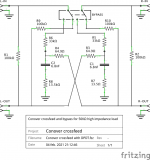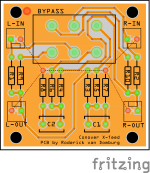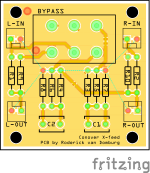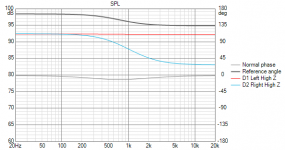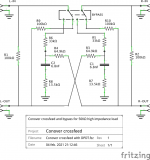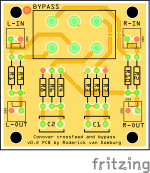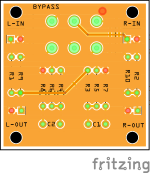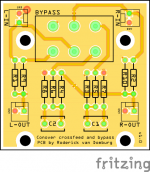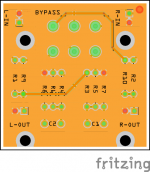So I'm in the market for a crossfeed for headphone listening. Long story short, I'm leaning towards a Conover crossfeed, designed a 50K high Z version of it with bypass, plus a PCB. Inviting reviewers and comments!
Current setup is as follows:
R-2R DAC 1,4Vrms 640Ω unbalanced out --> 50K stepped attenuator --> β22 headphone / pre-amp, 1MΩ in; <0,01Ω out --> 250Ω dynamic headphones
For this build I'm doing as much as discrete as possible; from the R-2R networks in the DAC straight up to the headphone jacks, it's completely discrete, solid state, with no op amp in sight.
With that in mind design goals are:
- resembling a monitor speaker-like setup
- fairly heavy or selectable crossfeed level; separation 3-6 dB or less
- psychoacoustically "objectively correct" center frequency (see below)
- otherwise no added EQ'ing
- 100% passive design
- with bypass for pre-amp duties or superstereo listening
- high Z design to stick in between line-level source and 50K attenuator
- preferably no caps in signal line for least sound coloration
Publicly-available crossfeeds that I considered:
- Linkwitz original: 700 Hz 3 dB derived from 1/2 wavelength distance from average ear-to-ear distance. This is what I mean with "objectively correct". High crossfeed level, which I like (listening to them from a bs2b DSP right now). An option.
- Chu Moy modified Linkwitz: Moderate levels, subjectively tuned. Bypass and level switching are nice additions. Cap in signal line, so not preferred.
- Jan Meier: Low levels. Not fully discrete, so put aside.
- Ohman: High levels. Interesting that crossfeed continues into midrange and treble regions, but decrease as frequency rises. Caps in signal line, so put aside.
- Conover: High levels. Like Ohman, frequencies past the center frequency continue to be crossfed however at a constant 75/25 mix. Inferred from ear-to-ear distance, citing a host of academic studies and verifying against it. Again "objectively correct". Fully discrete option available. There's a cap but only pulling to ground.
We have a winner... and some tinkering to do! Now I'm no EE by trade so would like to run some designs by you.
First, the passive design is a low Z configuration, intended to be stuck between the amp and in this case 100Ω headphones. Since I have a 50K attenuator I scaled all components by a factor 500. Is that 1:1 ratio OK between the crossfeed and attenuator?
Second, I added pads for a DPDT bypass switch. For level matching I parallelled resistors R9 and R10 to R1 and R2 for again an output impedance of 50K.
Third, designing my first ever PCB! How did I do? Where can I improve? I designed both single- and double-sided PCB options, which would you prefer?
Thanks for looking over my shoulder here. Also if more of you are interested in a production run, let me know.
Current setup is as follows:
R-2R DAC 1,4Vrms 640Ω unbalanced out --> 50K stepped attenuator --> β22 headphone / pre-amp, 1MΩ in; <0,01Ω out --> 250Ω dynamic headphones
For this build I'm doing as much as discrete as possible; from the R-2R networks in the DAC straight up to the headphone jacks, it's completely discrete, solid state, with no op amp in sight.
With that in mind design goals are:
- resembling a monitor speaker-like setup
- fairly heavy or selectable crossfeed level; separation 3-6 dB or less
- psychoacoustically "objectively correct" center frequency (see below)
- otherwise no added EQ'ing
- 100% passive design
- with bypass for pre-amp duties or superstereo listening
- high Z design to stick in between line-level source and 50K attenuator
- preferably no caps in signal line for least sound coloration
Publicly-available crossfeeds that I considered:
- Linkwitz original: 700 Hz 3 dB derived from 1/2 wavelength distance from average ear-to-ear distance. This is what I mean with "objectively correct". High crossfeed level, which I like (listening to them from a bs2b DSP right now). An option.
- Chu Moy modified Linkwitz: Moderate levels, subjectively tuned. Bypass and level switching are nice additions. Cap in signal line, so not preferred.
- Jan Meier: Low levels. Not fully discrete, so put aside.
- Ohman: High levels. Interesting that crossfeed continues into midrange and treble regions, but decrease as frequency rises. Caps in signal line, so put aside.
- Conover: High levels. Like Ohman, frequencies past the center frequency continue to be crossfed however at a constant 75/25 mix. Inferred from ear-to-ear distance, citing a host of academic studies and verifying against it. Again "objectively correct". Fully discrete option available. There's a cap but only pulling to ground.
We have a winner... and some tinkering to do! Now I'm no EE by trade so would like to run some designs by you.
First, the passive design is a low Z configuration, intended to be stuck between the amp and in this case 100Ω headphones. Since I have a 50K attenuator I scaled all components by a factor 500. Is that 1:1 ratio OK between the crossfeed and attenuator?
Second, I added pads for a DPDT bypass switch. For level matching I parallelled resistors R9 and R10 to R1 and R2 for again an output impedance of 50K.
Third, designing my first ever PCB! How did I do? Where can I improve? I designed both single- and double-sided PCB options, which would you prefer?
Thanks for looking over my shoulder here. Also if more of you are interested in a production run, let me know.
Attachments
Last edited:
Here's v1.0. I changed the mounting holes to be 30 mm center-to-center, so they mate with a bottom plate with a 10 mm grid. Final check anyone before I send it to production? If anyone's interested to obtain one, let me know.
